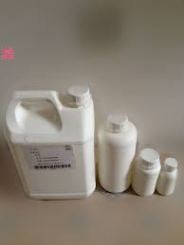Product name: 3-Bromobenzaldehyde
Synonyms: m-Bromobenzaldehyde, Benzaldehyde, 3-bromo-Benzaldehyde
Appearance: 3-Bromobenzaldehyde is white or light yellow liquid
Package:1kg/drum;20Kg/drum;200Kg/drum
Storage: sealed storage in shady and cool warehouse
Formula: C7H5BrO
Molecular Weight: 185.02
EINECS: 221-526-9
CAS NO.: 3132-99-8
Density: 1.577 g/cm3
Melting Point: 18-21 °C(lit.)
Boiling Point: 235.3 °C at 760 mmHg
Flash Point: 96.1 °C
Solubility: decomposes in water
Risk Codes: 22-36/37/38
Safety: 26-36
3-Bromobenzaldehyde is a white to pale yellow crystal. It is insoluble in water, soluble in ethanol and ether. 3-Bromobenzaldehyde mainly used for spices, dyes and organic synthesis intermediates.Preparation of 3-Bromobenzaldehyde is a bromine toluene as raw material, in the light bromide to generate bromobenzyl bromide compound is hydrolyzed under alkaline conditions, the last steam distillation, cooling and crystallization, washed with cold water and recrystallized from ether derived.
FIRST AID MEASURES
Description of first aid measures
General advice
Consult a physician. Show this safety data sheet to the doctor in attendance.
If inhaled
If breathed in, move person into fresh air. If not breathing, give artificial respiration. Consult a physician.
In case of skin contact
Wash off with soap and plenty of water. Consult a physician.
In case of eye contact
Rinse thoroughly with plenty of water for at least 15 minutes and consult a physician.
If swallowed
Never give anything by mouth to an unconscious person. Rinse mouth with water. Consult a physician.
Most important symptoms and effects, both acute and delayed
To the best of our knowledge, the chemical, physical, and toxicological properties have not been thoroughly investigated.
FIREFIGHTING MEASURES
Extinguishing media
Suitable extinguishing media
Use water spray, alcohol-resistant foam, dry chemical or carbon dioxide.
Special hazards arising from the substance or mixture
Carbon oxides, hydrogen bromide gas
Advice for firefighters
Wear self contained breathing apparatus for fire fighting if necessary.
ACCIDENTAL RELEASE MEASURES
Personal precautions, protective equipment and emergency procedures
Use personal protective equipment. Avoid breathing vapors, mist or gas. Ensure adequate ventilation.Evacuate personnel to safe areas.
Environmental precautions
Do not let product enter drains.
Methods and materials for containment and cleaning up
Soak up with inert absorbent material and dispose of as hazardous waste. Keep in suitable, closed containers for disposal.
EXPOSURE CONTROLS/PERSONAL PROTECTION
Control parameters
Components with workplace control parameters
Exposure controls
Appropriate engineering controls
Handle in accordance with good industrial hygiene and safety practice. Wash hands before breaks and at the end of workday.
Personal protective equipment
Eye/face protection
Face shield and safety glasses Use equipment for eye protection tested and approved under appropriate government standards such as NIOSH (US) or EN 166(EU).
Skin protection
Handle with gloves. Gloves must be inspected prior to use. Use proper glove removal technique (without touching glove’s outer surface) to avoid skin contact with this product. Dispose of contaminated gloves after use in accordance with applicable laws and good laboratory practices. Wash and dry hands. The selected protective gloves have to satisfy the specifications of EU Directive 89/686/EEC and the standard EN 374 derived from it.
Body Protection
Complete suit protecting against chemicals, The type of protective equipment must be selected according to the concentration and amount of the dangerous substance at the specific workplace.
Respiratory protection
Where risk assessment shows air-purifying respirators are appropriate use a full-face respirator with multi-purpose combination (US) or type ABEK (EN 14387) respirator cartridges as a backup to engineering controls. If the respirator is the sole means of protection, use a full-face supplied air respirator. Use respirators and components tested and approved under appropriate government standards such as NIOSH (US) or CEN (EU).
Want to learn more information about 3-Bromobenzaldehyde, you can access the guidechem.com. Guidechem.com is just a place for you to look for some chemicals.
